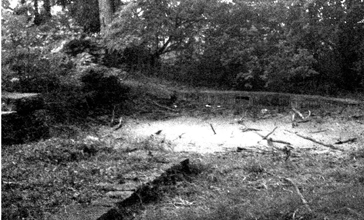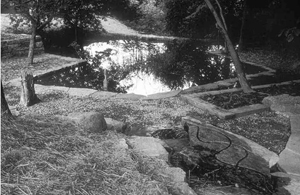ARTIST DECRIES NEGLECTED ARTPARK MASTER WORK
By James Hufnagel
 |
 |
| What remains of renowned artist Peter Richards’ (top)’ “The Spring” is a scum filled pond and overgrown vegetation, hidden from view. |
 |
Noted artist and landscape architect Peter Richards is now nearly 70 years old and lives in San Francisco. He's a dean of the American school of outdoor sculpture, having had more than two dozen exhibitions, won numerous awards and served on the faculties of Stanford and the San Francisco Art Institute. After reading the story of the decay and disrepair of his signature Artpark creation "The Spring" in the June 26th issue of the Reporter, he was deeply saddened.
"It looked pretty grim" he told me in a phone conversation last week, describing the recent photos we had taken documenting his neglected masterpiece, "and your article made me fairly depressed about it."
According to Wikipedia, "Artpark was founded in 1974. It became an important site for works of the Land Art movement. It was the site of Alan Sonfist's Pool of Earth, a 25-foot-diameter clay basin for catching aerial seeds, and projects by several women artists in the 1970s, including Michelle Stuart, Alice Adams and Agnes Denes and Nancy Holt. It continued to be an important laboratory for outdoor sculpture," including, of course, "The Spring".
Prof. Richards recounted the story of the cultural scene at Artpark, a story that is rapidly fading in the memories of those of lucky enough to have experienced it in its heyday. Busloads of schoolchildren from all over Western New York took field trips to the new park, where they spent the day watching artists paint and sculpt, enjoying theatrical performances in the woods and participating in all manner of artistic activities. This was long before the New York State Office of Parks, Recreation and Historic Preservation instituted the rock music concerts of present-day Artpark, accompanied by traffic jams, loud motorcycles, arrests and teenage drunkenness, as they impact the otherwise peaceful and quiet Village of Lewiston.
The Spring, Richards said, "was a project that spanned three years. The first year, 1987, we cleared the area and completed surveys, planning and topo(graphic) maps of the site. The second year we imported stone masons and at our peak, had 7-8 full-time workers. We even held a well-attended seminar for the public on stone masonry. It took us two months to build the dam, construct the edging and retaining walls, and carve the grooves and basin out of rock. The third year, 1989, we completed the project by adding fruit trees and various native plant species."
"It was important innovative work - it was the impetus for a lot of creative work - inspiration for a lot of artists."
Vonda Longin, a local artist who resides in Wheatfield, was a member of the team that assisted Richards more than two decades ago, and as project photographer captured the essence and subtleties of "The Spring". Longin recalls her time working with Peter Richards fondly. "He was a very nice man and a remarkable artist. It ("The Spring") was quite a big deal at the time.
Cutting-edge, contemporary artists from all over the country came to look at it."
Longin can understand perfectly Richards' dismay. "It's pretty disturbing, especially when you consider what Artpark was all about at one time."
Inspiration for the work came from the natural spring that flows down from Oak Hill. "The spring is an important aspect of Lewiston from a historical standpoint," said Richards. "Hundreds of years ago the water from the spring created a ravine that extended all the way to the (Niagara) Gorge. This is believed to be the first portage access point for the early French trappers. We know that an Indian village was also probably at the site, and this is where Joncaire established his trading post, one of the first in the region."
"Towards the late '80's when I became aware of the spring it was a trickle. I decided to restore it, and make it accessible to all."
The artist told me of the rift that developed between the grounds and program people, culminating in a collapse in funding for most Artpark activities in 1990. It was an invitation to an avant garde performance group that finally did it in. The troupe circulated a poster depicting the devil spearing a bible with his trident. In the context of the culture wars of the time, it was the last straw and State Parks pulled funding for programmatic activities at Artpark, including maintenance of the sculpture.
Today, "The Spring" stands not as a legacy, but as a monument to the bureaucratic indifference of New York State Parks. A $30,000 investment that was abandoned because, sadly, it did nothing to add to the agency's bottom line. The joy of discovery of the arts, the delighted joy of school children, the nurturing of an artistic community and the quiet dignity of a sculpture celebrating nature and our heritage have been replaced by boozy rock and roll revelries.
"I would like to see it restored. I might even come back to help." the master sculptor said.